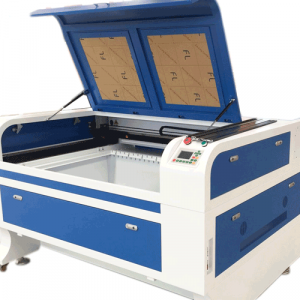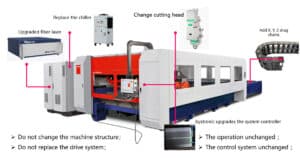Cleaning Lens
It’s necessary to maintain lenses regularly because of the characteristics of the laser cutting process. Once a week cleaning the protective lens is recommended. The collimating lens and focusing lens need to be cleaned once every 2~3 month. In order to facilitate the maintenance of the protective lens, the protective lens mount adopts a drawer type structure.
Lens cleaning
Tools: Dust-proof gloves or finger sleeves, polyester fibers cotton stick, ethanol, rubber gas blowing.
Cleaning instruction:
- he left thumb and forefinger wear the finger sleeves;
- Spray ethanol onto the polyester fibers cotton stick;
- Hold the slide edge of the lens with your left thumb and forefinger gently.(note: avoid the fingertip touching the surface of the lens)
- Put the lens in front of your eyes, hold the polyester fibers cotton stick with the right hand. Wipe the lens gently in a single direction, from bottom to top or from left to right, ( Should not be able to wipe back and forth, to avoid secondary lens pollution)and use rubber gas blowing to sway the surface of the lens. Both sides should be cleaned. After cleaning, make sure that there are no residues: detergent, absorbent cotton, foreign matter and impurities.
Removal and Installation of Lens
- The whole process need to be completed in a clean place. Wear dust-proof gloves or finger sleeves when removing or installing the lenses.
- The protective lens is a fragile part and needs to be replaced after damage.
- As shown in Figure 6.1, loosen two locking screws, hold the two sides of the drawer type lens mount and pull out the protective lens mount.
- Remove the pressure ring of the protective lens, remove the lens after wearing finger sleeves.
- Clean the lens, lens mount and sealing ring. The elastic sealing ring should be replaced if damaged.
- Install the new cleaned lens (Regardless of the front or back side) into the drawer type lens mount.
- Put the pressure ring of the protective lens back.
- Insert the protective lens mount back to the laser cutting head and tighten the locking screws.
Note: Do not directly pull the edge of the elastic sealing ring out so that it is easy to damage.
Removal and Installation of Collimating Lens
The procedures for removing and installing collimating lenses are as follows.
- Remove the laser head and move to a clean place. Clean all dust on the laser head surface;
- Use a 3mm inner hexagon spanner to loosen the screws of collimating components( as shown in figure 6.3), and seal the part(connected to collimating components) with Crepe Paper to prevent dust from falling inside the laser head.
- Unscrew the collimating lens mount and remove the spring pressure ring and the collimating lens with the lens removing tool;
- Clean or replace the collimating lens.
- As shown in figure 6.4, reassemble the collimating lens components in sequence. Note that the spring pressure ring is tightened properly and re-screwed into the collimating component.
- Tighten the locking screws of collimating components.
- Check if the focus position is at the center of the nozzle or not before using, if not , the position should be reset.
Removal and Installation of Focusing Lens
Removal and installation of focus lens refer to the steps as follows:
- Remove the laser head and move to a clean place. Clean all dust on the laser head surface.
- Place the laser head horizontally., remove the locking screws from bottom to top.
- Remove the spring pressure ring and focusing lens with a lens removing tool.
- Replace or clean the focusing lens.
- Put the focusing lens and the spring pressure ring in the lens mount carefully and tighten the pressure ring properly.
Turn the focusing lens back into the focusing lens mount and tighten it.
Reassemble and tighten the screws.
Check the focus position is at the center of nozzle or not. If not, you need to refer to the 3.1 step to reset the operation.
Replace Nozzle Connection Assembly
During the laser cutting, the laser head will inevitably be hit, so users need to replace the nozzle connector.
Replace Ceramic Structure
- Unscrew the nozzle.
- Hand pressing the ceramic structure so that it is not skewed, and then unscrew the pressure sleeve.
- Align the pinhole of the new ceramic structure with the 2 locating pins and press the ceramic structure by hand, then screw the pressure sleeve.
Screw the nozzle and tighten it properly.
Replace Nozzle
- Screw the nozzle;
- Replace the new nozzle and re-tighten it properly.
- Once the nozzle or ceramic structure has to be replaced,it must be re-capacitance calibration.
Fault Analysis
1.1.1 Alarm Information
ETC-F100 may generate the following alarm information:
1.Upper and lower limit alarm
This alarm is generated when the system detects a sensor signal of the Z-axis upper limit or lower limit. If not meet the requirements, please reset the sensor position. If this alarm is always displayed, check:
Limit signal is not connected to the ETC-F100;
Limit the sensor is obscured by unknown objects;
Limit sensor installed improperly (this possibility is extremely small);
The limit signal is disturbed. At this time, the corresponding limit signal may flicker in the function test, especially after the motor is enabled. The ETC-F100 and the 24VDC limit signal can be independently powered A power filter is needed for the 220V AC of the Servo driver, and to ensure that the ground wire grounding well.
2.“Zero returning”Alarm
After the system is powered off and restarted, the controller needs to go back to zero to establish a reference coordinate system. If there is no back to zero, the panel will prompt ” Zero returning “,It can be solved by the following methods:
Perform a zero return operation through the ETC-F100.
Select “Yes” and save it in the “power-on Reset”, and it will automatically return to zero after power-on again.
High level can be input through “Zero returning” interface to realize backing to zero.
3.“Exceeding z-axis stroke”Alarm
This alarm is generated when the actual Z-axis coordinate exceeds the Z-axis travel. When this alarm occurs, please note:
1) Z-axis travel setting is appropriate;
2) Whether the location of dial overtravel.
4. “Servo Alarm”
Under normal circumstances, when the drive alarm, “Servo Alarm”will be displayed by ETC-F100. If the drive is normal, and the ETC-F100 displays the “Servo Alarm”, it may be caused by the following conditions:
Servo driver wiring is incorrect;
External interference.
1.1.2 Common Problems Analysis
1.“Servo Calibration” process terminated abnormally
1) dial in the upper limit
When the dial is in the upper limit position, this error occurs when servo calibration is performed.
2) dial position near the upper limit
The dial position near the upper limit (about 1mm), this error will occur in servo calibration.
In this condition, please move the dial to the middle of the stroke (more than 1mm), and then take the servo calibration.
2. The screen is abnormal displayed
The external interference may cause the screen to display abnormally, please reboot the ETC-F100 when this abnormality occurs.
3. Z-axis coordinate offset
Under the static state, the Z axis coordinate keeps changing slowly, in this condition, the servo calibration can be restarted.
4. Input signal jitter or invalid
If the input signal is Jittering or invalid, enter the I / O port detection interface of the function test, directly connect 24V (active high) or 0V (active low) of the 24V DC power supply to the corresponding input port, and observe whether the corresponding number is inverted :
For high effective input signal, 24V can be directly connected to the corresponding input port, if the corresponding number is inverted, then the board is normal;
For low effective input signal, 0V can be directly connected to the corresponding input port, if the corresponding number is inverted, then the board is normal.
After ensure the board is normal, access the input signal. If the number is jittering, the input signal may be unstable. Please make sure that the 24V power of the input signal is in common ground with the ETC-F100 power supply and then remove the interference and test again.
If the number is not inverted, please check the input signal is valid or not.
This article is only for learning without any commercial value, part of the point of view is extracted from https://www.raytools.ch/







